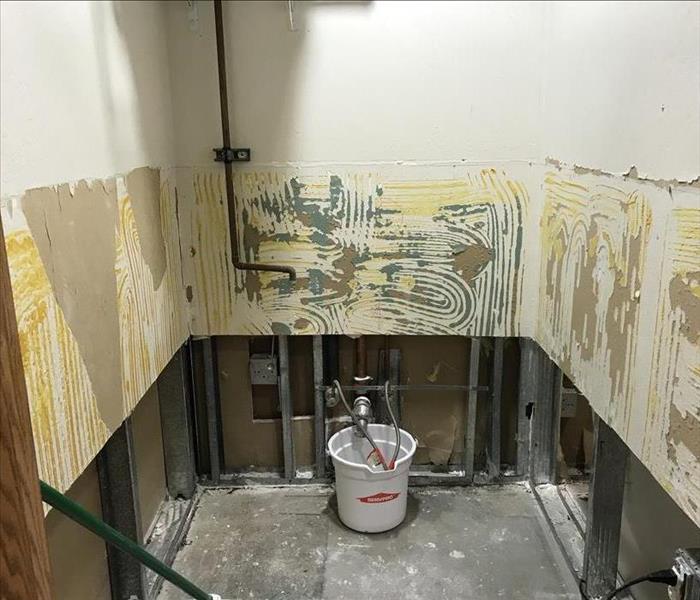Will the Walls and Floors with Floodwater Dry on Their Own?
4/27/2020 (Permalink)
 Do you have storm damage in your Los Gatos home? Call SERVPRO to mitigate the flood issues that containmentated your house.
Do you have storm damage in your Los Gatos home? Call SERVPRO to mitigate the flood issues that containmentated your house.
SERVPRO Has the Advanced Equipment to Make Water Damage a Thing of the Past in Your Los Gatos Home
When floodwater enters your Los Gatos home, the timer starts ticking on the loss. Even an inch of water can wind up behind the baseboards, within the sheetrock and seep into the flooring. It is crucial to get the water extracted and the property dried as soon as possible after the water loss event to limit the damage to the structure and contents.
What Are Some of the Dangers of Floodwater in a Home?
Even brief exposure to flood damage can leave a Los Gatos home with a host of restoration challenges. When entering the loss area, be aware of the following scenarios:
- Warped floorboards
- Delaminated resilient tiles can cause slip and fall accidents
- Floor outlets in contact with the water can cause shock
- Possible contaminants make the water dangerous to handle
- If you remove anything from the water, wear gloves and other needed PPE personal protective equipment. Leave other items in location for SERVPRO techs to inspect and clean
Testing the Water Before Cleanup is Vital
When floodwater enters your home, it picks up anything on the way there. If it flows through mud, chemicals, or a backed-up drain containing sewage, all of it has the potential to contaminate your house. There are different types of water testing that SERVPRO technicians have access to. They can tell if any harmful bacteria or pathogens are present in the water and treat it proactively before handling it during mitigation efforts.
Can I Use a Wet/Dry Vac to Remove Floodwater?
Household shop vacuums are great for removing small amounts of liquids from surfaces; however, they lack the pulling power needed to extract embedded moisture from within flooring and wall cavities. The portable pumps brought on-site by SERVPRO can remove more water at an expedited pace, and ready the loss area for drying much faster.
Particular Actions Needed for Flood Loss Affecting Walls
Water wicks rapidly into building materials when it enters the home. This extent of the damage may not be readily evident through visual inspection. When scoping a room for the migration paths of water, it can wind up in surprising areas, far away from the origination point of the loss. The techs use different types of detection equipment to "see" behind walls and under most flooring types to detect elevated areas of moisture, so they know where to focus their efforts. The sheetrock continues to wick moisture, and it can travel several inches upward. The techs measure over the highest watermark on the wall referred to as a "waterline" and cut the sheetrock off several inches above that point. This halts any further loss and makes repairs easy after the mitigation efforts complete.
Flooring Needs Fast Action for Floodwater Removal
SERVPRO technicians get to work on arrival and begin extraction efforts and moving items out of the flood loss area. The type of flooring and water depth dictates the kind of water extraction equipment needed. When water is greater than two inches deep, submersible and truck-mounted pumps, get used until the water is low enough to bring in other forms of extraction equipment. Portable pumps are ideal for allowing the techs to move quickly around a loss area and pull up the water. Squeegees and other manual tools such as mops get used on slab substrate to ready it for drying.
Laminate vinyl tile flooring often has seepage issues into the subfloor and may lose adhesion. Hardwood floorboards get inspected on a case by case basis for restoration through the advanced drying and cleaning applications. Composite flooring tends to react poorly to water exposure and many times is a loss. Ceramic tile frequently holds up against even extensive floodwater when the seal on the grout remains intact.
Items That May Have No Recovery Potential After a Home Flood
Although the advanced cleaning and restoration methods go a long way towards helping property owners lessen loss after a flood in their home, some things may not be recoverable. Groundwater carries a rating as a class three biohazard for a good reason; there are often numerous harmful elements present. For that reason the following items usually have no restoration potential after exposure to floodwater:
- Saturated carpet and padding
- Sofas and loveseat with warped or cracked frames from swelling
- Pillows and fabric items
- Food items compromised by the water needs disposal
- Electronics need to get inspected by an industry professional to see if they require repair and are safe for use
- Composite flooring fares poorly against water absorption
SERVPRO of Los Gatos / Monte Sereno at (408) 600-2020 has certified technicians available 24/7 to handle any size flood damage cleanup and restoration in your home, call today.






 24/7 Emergency Service
24/7 Emergency Service